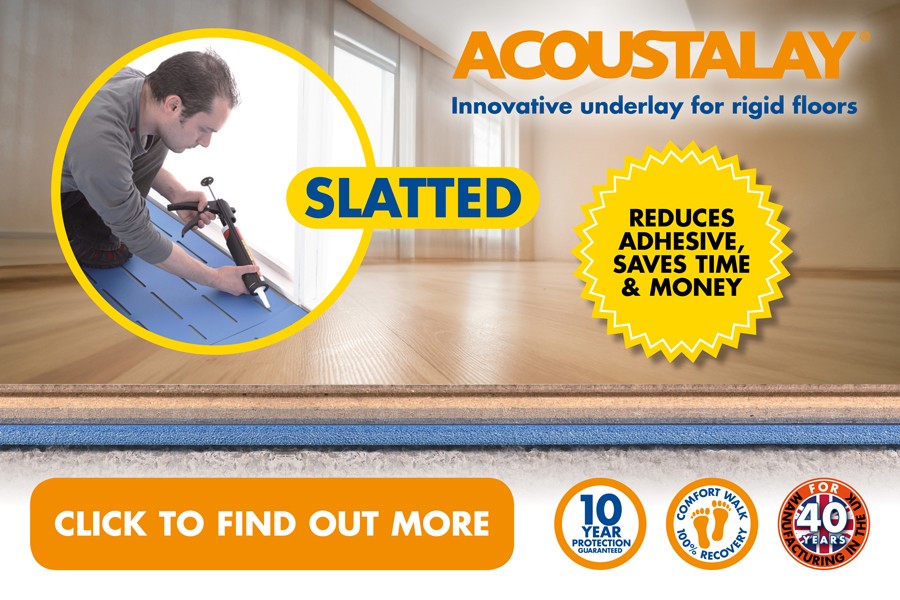Plywood or smoothing compound? What’s your preference when preparing a boarded floor to receive dry back LVT?
A retailer called me in some panic. They had used a fibre-reinforced smoothing compound over some floorboards about three years ago and now their customer was complaining that ridges were appearing in the floor. The floor layer had gone to take a look and had found that there was a high moisture level under the tiles, but the floorboards had been dry when tested before the original installation, so the customer must have blocked up the airbricks providing ventilation to the void under the floorboards.
The issue had been adjudged by an independent arbitrator who had ruled that the consumer must have the airbricks reinstated and then the retailer must replace the flooring. However, the builder contracted to fix the airbricks could not do the work because it was a solid subfloor after all. The arbitration ruling was therefore, ironically, void.
The retailer could not understand what was going on, hence the call to me and a few days later I visited the customer’s home. The flooring would have to be replaced, so the customer and retailer agreed that I could dig into the floor to find out what was going on for sure.
Before the appointed date, however, I received another call from a customer in the same area who had an LVT floor in which ridges were appearing. Someone had taken up a tile and found that the plywood itemised on the quotation had been changed to a smoothing compound and the caller felt this was likely to be the issue.
He promised to send some photographs, but the ridges were not very easy to see and needed the light to fall just right. Photos got sent over in a trickle as the light varied throughout the next two days, and we exchanged questions and answers so I could understand the complaint more fully.
I visited customer one. The house was set between two houses which each had foundation stones dated 1901 (it pays to keep your eyes open for external clues even before you start an inspection). The customer told me his house had been built a few years later, probably about 1930.
I took a look at the flooring to see the ridges and then chose an area underneath a sideboard to do my investigation so it would not be a hazard for the young family before the remedial work was done.
Moisture readings were high throughout the installation and this was confirmed by using different types of meter. When I lifted one of the herringbone strips, the reading directly from the subfloor was at maximum. I chiselled through 8mm of smoothing compound then 25 mm of beautiful pine floorboard to find a bed of bitumen adhesive with a sand and cement screed below. This is a common installation method in older properties, although usually the flooring is a parquet rather than floorboards.
After the visit I put my report together and sent it off to the retailer. The problem was easy to diagnose and the remedy was simple but expensive. I pointed out that any property bult before 1970 is unlikely to have a ‘structural dpm’ – that is, a physical membrane between the ground and the concrete floor so a higher moisture level is to be expected and if this moisture is trapped beneath a plastic or other waterproof product it will build up and, unless a surface-applied damp-proof membrane is used this can lead to flooring failure, in this case because of the warping of the timber as it soaked up the trapped moisture.
As expected, I then received a call from the retailer’s MD whom I have known (at a distance) since the earliest days of my career. He had read my report in detail and accepted what I was advising. But he had one question which I could not answer: ‘Why has no-one ever told me about pre-1970 properties in all my years in the trade?’ he asked. Of course, from my perspective, I’m amazed someone in his position, and with a good flooring team in his company, could not have known. Perhaps he had been lucky, or perhaps other faults had been mis-diagnosed because no-one understood this.
Here’s the summary of what you need to know: Until the invention of double glazing and central heating buildings were naturally ventilated by the chimneys and single-glazed windows with draughty frames and so the moisture contact of a screed floor was able to escape to air and was harmless. Then came a rush to install the latest heating and window technology, so buildings trapped the moisture along with the heat and the era of black mould and rising damp began. Once this was recognised and understood, building regulations were changed to require a structural dpm. This applied from about 1970 onwards, but the reason this is not a firm date is because plans which were approved under the old regulations did not have to be changed, nor did buildings already partly built. Therefore any floor layer should take special care when estimating and installing into an older property. Had the floorboards been laid on joists with ventilation below, moisture checks should still be carried out to check the humidity levels.
This brings me to customer two. Just after I had finished the inspection I had another photograph from customer two, this time to show me that the ridges were across the entire floor at sixteen inch intervals. It was a chipboard floor, rather than floorboards, and the chipboard was clearly sagging between the joists.
I advised the customer accordingly and he could understand this and wasn’t going to pursue his complaint as he could see it was just the ageing of his flooring. Some might take the view that using ply instead of smoothing compound could have prevented this happening.
www.richard-renouf.com
Richard Renouf is an independent flooring consultant


